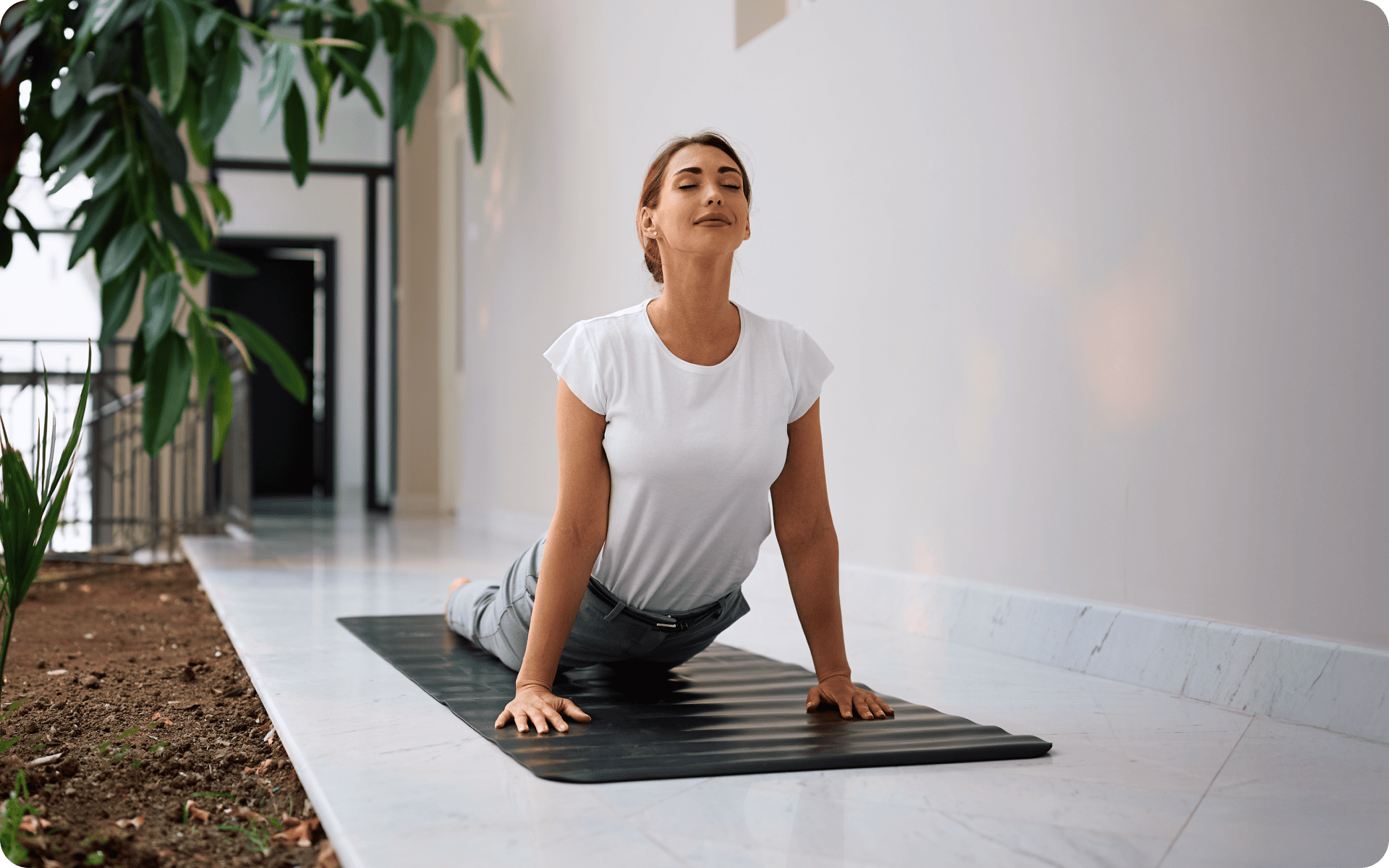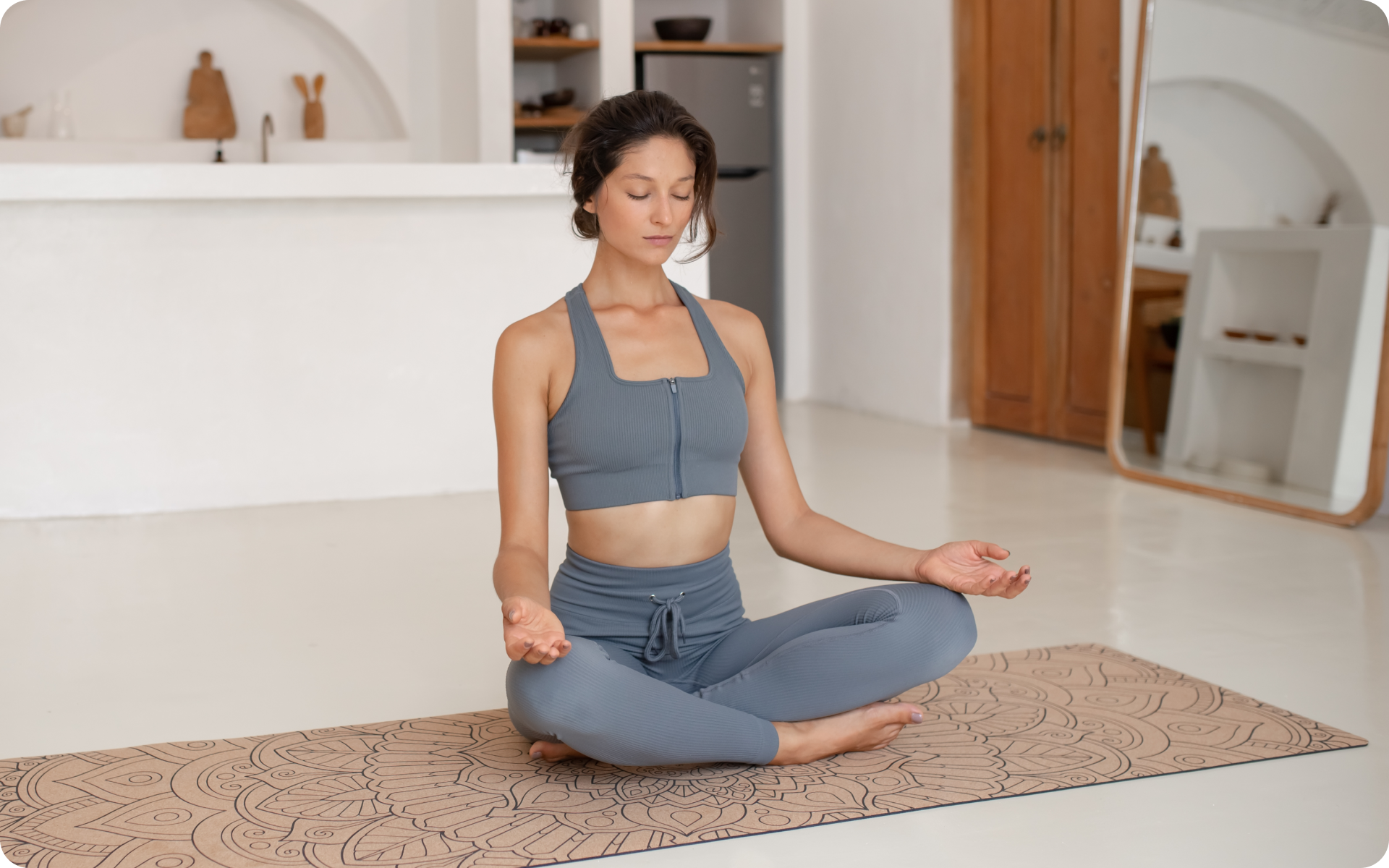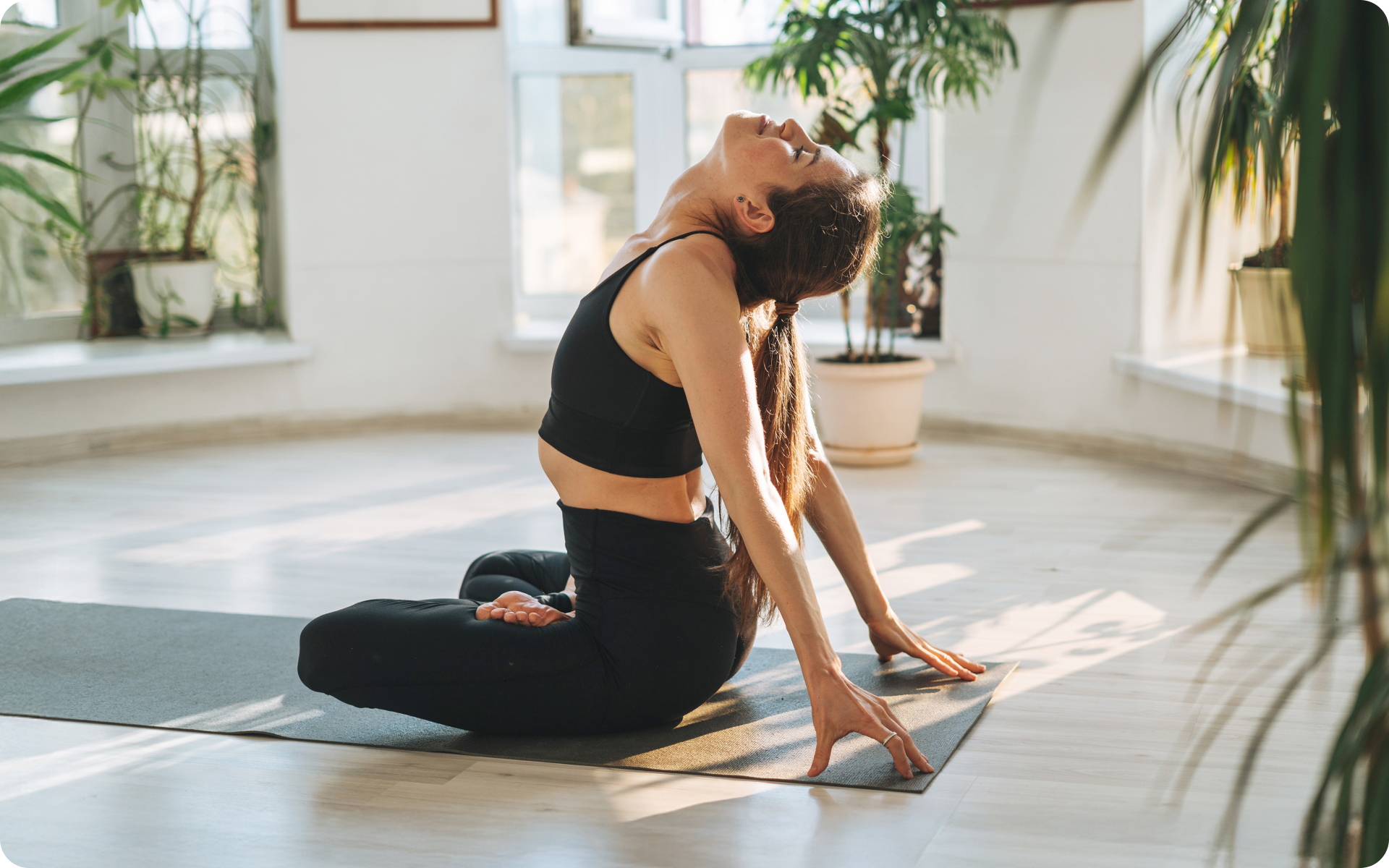In the whirlwind of daily life, it’s easy to overlook the signals our bodies send us, whether it’s the tightening of muscles after a stressful day or the subtle cues of tension lingering in our shoulders. We all experience stress from time to time and it’s a natural reaction to life’s ups and downs (12).
However, when stress starts to mess with our day-to-day routines, it’s time to take notice. Fear not, there’s a silver lining to all this. If you’re finding yourself bogged down by stress-related aches and pains, or if you’re just someone who seems to carry stress, there’s something that may just help you: somatic workouts.
Think about it: stress doesn’t just mess with our minds; it can also wreak havoc on our bodies, diminishing our quality of life (13). When stress hits us out of the blue, our muscles may clench up as a reflex reaction, only to loosen up once the stress eases off. However, if we’re dealing with stress regularly, our muscles may decide to stay on high alert, potentially causing stress-related disorders.
It’s not just our muscles that feel the strain – our breathing can be affected too. Have you ever felt as if you couldn’t catch your breath when stressed? That’s because stress can cause the airways to tighten up, making it harder to take in those calming breaths.
Our inbuilt system called the autonomic nervous system, which plays a pivotal role in the body’s physical responses such as heartbeat and breathing kicks into overdrive when we feel stressed. This triggers what’s known as the “fight, flight or freeze” response, which is our body’s way of getting ready to either face a challenge head-on, freeze in position, or make a run for it.
So, next time you’re feeling stressed out and your body starts sending you those signals – whether it’s a knot in your stomach or a tightness in your chest – don’t ignore them. Your body is trying to tell you something and it’s important to listen.
Somatic workouts are all about reconnecting your mind and body, and by diving into these exercises, you’ll not just be addressing the physical tension in your muscles, you’ll also be giving your mental well-being a much-needed boost.
What Are Somatic Workouts?
“Somatic” refers to the body, as opposed to emotional dimensions such as thoughts and feelings (9). Therefore, somatic workouts are exercises that focus on the mind-body connection, with the aim of promoting physical and mental well-being.
Unlike traditional workouts that may have you sweating it out on a treadmill or pumping weights at the gym, somatic workouts take a more introspective approach, which helps you heighten awareness of your bodily sensations and gain insight into the ways in which stress and tension manifest physically, allowing the promotion of relaxation.
These exercises can include intentional movements, grounding techniques, breathwork, and gentle stretches.
Running a never-ending rat race, shoving trauma further and further away, falling into self-harming thought patterns, living life that’s eclipsed by constant anxiety and fear – this is what an average person goes through every day. Not addressing it will only pull you deeper into a downward spiral. BetterMe: Meditation & Sleep app will help you gain a new perspective on life and help you regain that long-lost internal balance!
Somatic Meditation Exercises
So, if you’re ready to take your self-discovery journey to the next level and prioritize your overall well-being, why not give somatic workouts a try? Here are 4 somatic exercise techniques you can try at home to improve your physical and mental well-being:
Mindful walking
Before you start your walk, notice how your body feels. Now, take a few deep breaths and start your walk at a slow pace in a quiet and peaceful environment, such as a park or nature trail. As you walk, notice the sensations of each step: the feeling of your feet connecting with the ground, the movement of your feet, legs, and arms as you take every step, and the rhythm of your breath.
Notice your foot as it touches the ground and moves from the heel to toe. Notice any thoughts or distractions that arise without any judgment, and gently bring your focus back to the present moment and the sensations of walking.
Body-scan
Find a comfortable position, either sitting or lying down. If you’re seated, allow your back to be straight (not stiff), with your feet on the ground. Rest your hands gently on your lap or on your sides.
Allow your eyes to close or remain open with a soft gaze and slowly bring your attention to your breath. Start shifting your attention internally. You may be distracted by sounds in the room. Simply notice this and bring your focus back on your breathing.
Start to slowly scan your body starting from your toes and moving upward to your head, noticing any areas of tension, discomfort, or sensation without any judgment. You can imagine sending your breath down to each body part. To release any tension, allowing yourself to fully relax into each moment.
Once you’ve completed your scan, take a full, deep breath, taking in all the energy of this practice, and exhale fully through your mouth. When you’re ready, slowly open your eyes and return your attention to the present moment.
Somatic Breathwork Exercises
Before you start these exercises, find a comfortable position either seated or lying down in a comfortable position with your back straight and your shoulders relaxed. Close your eyes or keep them open with a soft gaze.
Diaphragmatic breathing
Place one hand on your chest and the other on your abdomen to help you feel the movement of your breath. Take a few normal breaths to relax your body and bring your attention to your breathing.
Now take a deep inhale through your nose, allowing your abdomen to expand like a balloon as you breathe in. When you breathe into your belly, your chest and shoulders will remain still and only your belly will expand. Exhale slowly through your mouth and feel your abdomen contract and flatten as you do so.
Continue to inhale deeply through your nose and exhale slowly through your mouth, focusing on the rhythm of your breath. Allow every breath to be smooth, steady, and relaxed. You can continue this for approximately 5-10 minutes and when you’re ready to close the practice, slowly bring your attention to the present moment.
Box breathing
Visualize a box with four equal sides. With every step, imagine you’re following or tracing one side of the box. Start at the top corner of the box and work your way around the box until you return to the starting point.
As you follow the top side of the box, slowly and gently inhale through your nose, counting to four as you fill your lungs with air. As you follow down one side of the box, hold your breath for a count of four, then follow the bottom side of the box and exhale slowly for a count of four.
Then, follow the other side of the box and hold your breath for another count of four. Repeat these steps four or five times. If you feel that the count of four is too long, you can adjust it to two or three, based on what feels more comfortable to you.
Focus on the rhythm of your breath and try to maintain a smooth and steady pace. With regular practice, you’ll be able to hold for a count of four.
Read more: Somatic Healing Techniques: A Holistic Approach to Physical and Emotional Recovery
Do Somatic Workouts Actually Work?
You may be wondering if these exercises are just another wellness trend or if they truly deliver on their promises. Emerging research suggests the advantages of somatic exercises such as breathwork in improving mood and reducing the symptoms of stress, depression, and anxiety (3, 5, 2).
In addition, somatic movement techniques such as the Feldenkrais Method, the Alexander Technique, and Laban Movement Analysis that guide you to develop a deeper connection with your body have shown promise, particularly among individuals suffering with injuries and chronic pain (4).
They have also helped people cope with symptoms of Parkinson’s disease and improved emotional resilience (8). In essence, somatic workouts offer a holistic approach to improving both physical and mental health (1).
What Is a Somatic Workout for Weight Loss?
Although somatic workouts alone will not result in weight loss, they can be incorporated into your fitness schedule due to their many benefits.
One of the key benefits of somatic exercises is their ability to address stress, which is a common factor that contributes to weight gain due to elevated cortisol levels (7). Whether it’s somatic mindful techniques, somatic yoga, or dance movement therapy, these techniques can help you kick stress to the curb, which makes it far less likely for you to turn to food when emotions run high.
Somatic workouts also promote better flexibility, enhanced balance, strengthened mind-body connection, and body positivity (17). These attributes facilitate improved physical fitness and also encourage you to make mindful choices regarding your diet and fitness regimen.
Do Somatic Exercises Release Trauma?
Now, let’s talk about something a little deeper: trauma. Trauma is “an emotional response to a terrible event such as an accident, rape, or natural disaster (15).”
For many people, recovery from difficult experiences is managed through innate coping mechanisms or with support, while for some, unaddressed traumatic events may lead to psychological disorders, which highlights the importance of releasing pent-up emotions linked to distressing events to help with the recovery process.
Somatic exercises and therapies can be particularly beneficial in facilitating this process as they work “bottom up” by using the body as the entry point to track the sensations associated with memories of the traumatic event.
With the guidance of a trained therapist, somatic therapies such as Somatic Experiencing (SE) therapy (11), Sensorimotor Psychotherapy, and Eye Movement Desensitization and Reprocessing (EMDR) can be used to treat any deeply rooted negative unresolved emotions that are stored in the body due to having experienced a distressing event (11).
Somatic exercises such as breathwork and grounding exercises are also great tools for managing symptoms of psychological disorders such as anxiety, depression, chronic stress, and post-traumatic stress disorder (PTSD 3)
BetterMe: Meditation & Sleep app can help you transmute stress into serenity, pull you up from the doldrums, free your mind from the cares and worries of the world, quell racing thoughts and infuse you with tranquility! Start using it now and change your life!
FAQs
Are somatic exercises the same as yoga?
Not quite. However, somatic yoga (16) combines somatic principles and traditional yoga and offers advantages such as enhancing quality of life and flexibility (6). It is advisable to practice under the guidance of a certified somatic yoga instructor.
Is Pilates a somatic exercise?
The Pilates method is known to enhance strength and flexibility. While it’s not traditionally classified as a somatic practice, it shares common principles and characteristics with somatic approaches.
Is tai chi a somatic exercise?
Tai chi is a mind-body practice that involves slow, flowing movements, deep breathing, and mindfulness techniques. It incorporates somatic elements as it focuses on cultivating body awareness, relaxation, and balance through gentle movement and breathwork (14).
Finding Your Rhythm: How Often Should I Perform Somatic Exercises?
Incorporating somatic exercises into your daily routine is entirely your choice and it can be incredibly beneficial. Ultimately, the key lies in listening to your body such as subtle signals and cues that arise during somatic practice.
In conclusion, in a fast-paced world that prioritizes productivity and achievement over well-being and self-care, somatic workouts remind us to slow down and listen to our bodies, offering a pathway to self-discovery and transformation.
DISCLAIMER:
This article is intended for general informational purposes only and does not serve to address individual circumstances. It is not a substitute for professional advice or help and should not be relied on for making any kind of decision-making. Any action taken as a direct or indirect result of the information in this article is entirely at your own risk and is your sole responsibility.
BetterMe, its content staff, and its medical advisors accept no responsibility for inaccuracies, errors, misstatements, inconsistencies, or omissions and specifically disclaim any liability, loss or risk, personal, professional or otherwise, which may be incurred as a consequence, directly or indirectly, of the use and/or application of any content.
You should always seek the advice of your physician or other qualified health provider with any questions you may have regarding a medical condition or your specific situation. Never disregard professional medical advice or delay seeking it because of BetterMe content. If you suspect or think you may have a medical emergency, call your doctor.
SOURCES
- A Somatic Movement Approach to Fostering Emotional Resiliency through Laban Movement Analysis (2017, frontiersin.org)
- Brief structured respiration practices enhance mood and reduce physiological arousal (2023, ncbi.nlm.nih.gov)
- Effect of breathwork on stress and mental health: A meta-analysis of randomised-controlled trials (2023, nature.com)
- Evidence for the effectiveness of Alexander Technique lessons in medical and health-related conditions: a systematic review (2012, pubmed.ncbi.nlm.nih.gov)
- How Breath-Control Can Change Your Life: A Systematic Review on Psycho-Physiological Correlates of Slow Breathing (2018, ncbi.nlm.nih.gov)
- Impact of Somatic Yoga and Meditation on Fall Risk, Function, and Quality of Life for Chemotherapy-Induced Peripheral Neuropathy Syndrome in Cancer Survivors (2019, journals.sagepub.com)
- Obesity and Stress: A Contingent Paralysis (2022, ncbi.nlm.nih.gov)
- Randomized controlled trial of the Alexander Technique for idiopathic Parkinson’s disease (2002, journals.sagepub.com)
- Somatic (2018, dictionary.apa.org)
- Somatic experiencing: using interoception and proprioception as core elements of trauma therapy (2015, frontiersin.org)
- Somatic Experiencing for Posttraumatic Stress Disorder: A Randomized Controlled Outcome Study (2017, ncbi.nlm.nih.gov)
- Stress (n.d., apa.org)
- Stress effects on the body (2023, apa.org)
- Tai Chi and Qigong for the Treatment and Prevention of Mental Disorders (2014, ncbi.nlm.nih.gov)
- Trauma (n.d., apa.org)
- What is Somatic Yoga? (n.d., denizaydoslu.com)
- “I hate my body”: Somatic Movement Practices and Body Image (2022, liebertpub.com)











